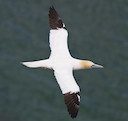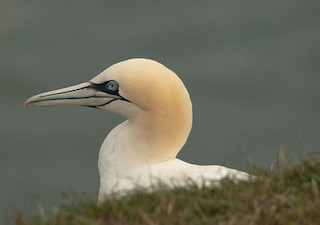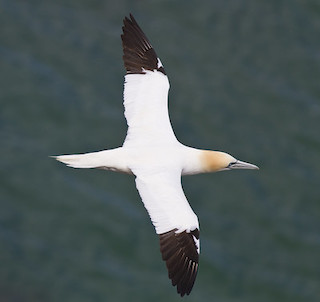 Gannets do not breed on the Lizard, but can be seen flying past over the sea as they hunt far and wide for food.
Gannets do not breed on the Lizard, but can be seen flying past over the sea as they hunt far and wide for food.
Photo: © Natural England/AllanDrewitt
Scientific name: Morus bassanus
Other common names: Gannet, Spectacled Goose
Conservation status: Amber status in Britain (Birds of Conservation Concern), because of the important breeding colonies.
What to look for:
- Colouring: Bright white body, black tips to its long wings, with a pale yellow tinge to the head in the breeding season. The eyes are pale blue ringed by bare blue skin.
- Size: Large, length of <90 cm and wingspan of over 1.5 m
- Where: All round the coastline. Its worldwide distribution is mainly both sides of the North Atlantic.
- Call: ‘Cackle’-like noises.
- Similar species: Very similar to the Australasian Gannet of the southern hemisphere, but the ranges do not overlap.
 Northern Gannet breeding colonies in Britain are on offshore islands in Scotland and Wales, including St Kilda and Bass Rock, with two mainland colonies at Troup Head in Scotland and Bempton Cliffs in Yorkshire. These sites together host almost 70% of the world’s breeding Gannet population (around 220,000 nests compared to around 300,000 in Europe as a whole; source: BTO).
Northern Gannet breeding colonies in Britain are on offshore islands in Scotland and Wales, including St Kilda and Bass Rock, with two mainland colonies at Troup Head in Scotland and Bempton Cliffs in Yorkshire. These sites together host almost 70% of the world’s breeding Gannet population (around 220,000 nests compared to around 300,000 in Europe as a whole; source: BTO).
Nonetheless, this striking white and black seabird can be seen all around the British coastline as it travels to hunt for food low over the water, sometimes singly, sometimes in groups flying together in a row. The Gannets we see around the Lizard, including Lizard Point, are mostly young, non-breeding birds that are passing through while feeding; the nearest breeding colonies are in Alderney (Channel Islands), France and Grassholm (Wales).
 A Gannet can reach up to 100 km per hour as it executes its spectacular plummeting dives into the sea, from as high as 40 m, plunging into shoals of fish to capture a meal of mackerel or herring or other fish, usually eaten underwater before resurfacing. It has evolved air-sacs positioned to cushion the impact as it hits the sea surface at these high speeds.
A Gannet can reach up to 100 km per hour as it executes its spectacular plummeting dives into the sea, from as high as 40 m, plunging into shoals of fish to capture a meal of mackerel or herring or other fish, usually eaten underwater before resurfacing. It has evolved air-sacs positioned to cushion the impact as it hits the sea surface at these high speeds.
During the breeding season, which starts in January in Scotland, birds nest close together in large colonies. A Gannet pair is monogamous, often staying together for life and certainly for many years (Gannets have been known to live up to well over 30 years). The large nests are constructed by the male bird from various plants and materials, including seaweed. Each pair defends its nest site aggressively. Only one egg is laid, but a second may follow if the first is lost, due to predation for example. The chicks are at first fed regurgitated fish by their parents, followed by whole fish once they are larger. Birds leave the nesting site by the early autumn, spending the colder months of the year at sea and migrating southwards.
Did you know…?
…Immature Gannets may return to a different breeding colony from that where they were born until they reach breeding maturity. However, once they have paired and bred at a colony for the first time, they remain faithful to that site.
…The colony at Bass Rock is the largest in the world. This site gives it its species name of bassanus. The genus name Morus is from the Greek meaning ‘silly’ or ‘dull’.
More information and references:
Gooders, J. and Harris, A., 1986. Field Guide to the Birds of Britain and Ireland. Kingfisher Books, London.
Published: April 2014
Author: Amanda Scott
Photos: Gannet on cliff (© Natural England/Neil Pike), Gannet in flight (© Natural England/AllanDrewitt)
